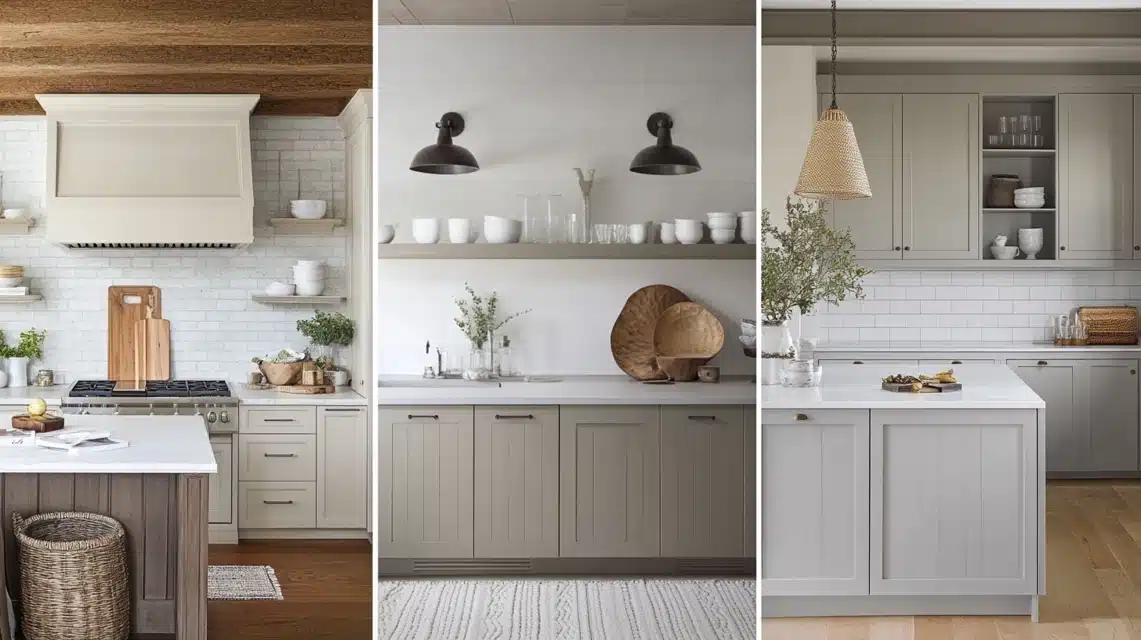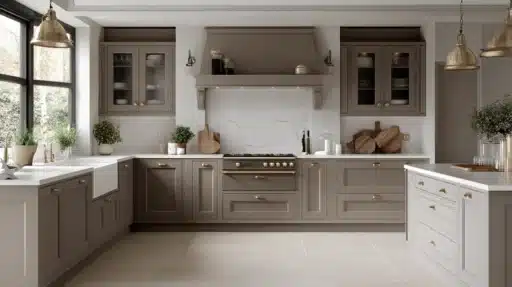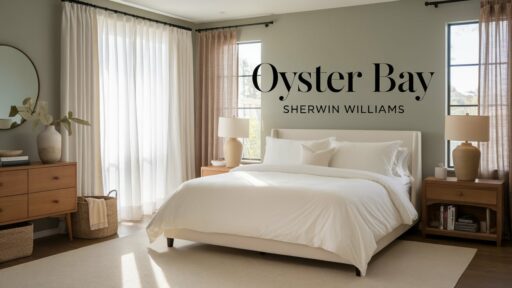I want to help you understand mushroom cabinet colors, a blend of soft browns and grays that make kitchens feel warm and welcoming.
In this guide, I’ll explain these colors and how to choose between gray and beige tones.
Additionally, I’ll cover the top paint brands to consider and the steps to paint your cabinets.
Plus, I’ll share why these colors stay relevant year after year. Let us begin!
What is mushroom color, and how does it look in different lighting?

Let me tell you about mushroom colors and their behavior in your home. Think of soft browns mixed with gray—that’s what we call a mushroom shade.
I’ve seen how these colors can look quite different as the day progresses.
Your mushroom cabinets might look lighter and warmer in a room with lots of sunlight.
The same color can appear more muted when artificial lights are used at night. North-facing rooms show these colors differently than south-facing ones.
Here’s my key tip: Get a paint sample first. I always tell my clients to look at the color in morning light, midday sun, and evening hours. This small step helps you avoid any surprises after painting.
Is mushroom more grey or beige?
These shades sit right between gray and beige – but each paint can lean more toward one side.
I’ve worked with both light and dark mushroom colors. Some, like Swiss Coffee by Benjamin Moore, stay close to beige with just a touch of gray.
Others, like Stone Hearth, show more gray while keeping warm brown notes.
The fun part? You can pick how much gray or beige you want. Lighter mushroom colors like Edgecomb Gray give you a soft, mild mix.
Darker ones like Mouse’s Back offer deeper brown-gray combinations. It’s all about what feels right in your space.
DIY Guide: Paint your cabinets in mushroom tones
Step 1: Pick Your Color (1-2 Days)
- Get sample paints of 2-3 mushroom shades
- Paint small spots on your cabinets
- Check colors at different times of day
- Note how they look on your counters and walls
Step 2: Prepare Your Space (2-3 Hours)
- Remove cabinet doors and hardware
- Label each door’s location
- Cover counters with drop cloths
- Set up a painting area
Step 3: Clean Thoroughly (2-3 Hours)
- Wipe cabinets with a degreaser
- Clean all surfaces twice
- Let dry completely
Step 4: Sand and Prime (1 Day)
- Sand all surfaces lightly
- Wipe away dust with a cloth
- Apply primer
- Let dry overnight
Step 5: Paint Application (2-3 Days)
- Use small foam rollers for flat areas
- Paint brushes for details
- Apply thin coats
- Wait 4-6 hours between coats
- Add 2-3 coats total
Step 6: Final Steps (1-2 Days)
- Let paint dry for 24 hours
- Put the hardware back on
- Rehang doors
- Touch up if needed
Tips From My Experience:
- Keep room temperature steady
- Use good lighting
- Take your time between coats
- Don’t close doors fully for 3-4 days
Total Time: 5-7 days for best results
Cost Note: I spent about $200 on my brother’s kitchen cabinet update, including paint, tools, and supplies.
Mushroom paint colors by different brands
| Brand | Paint Color | Description |
|---|---|---|
| Benjamin Moore | Swiss Coffee | Warm off-white with subtle gray; perfect for bright spaces |
| Benjamin Moore | Revere Pewter | Light to medium mix of gray and beige; shifts with lighting |
| Benjamin Moore | Stone Hearth | Light brown-gray; warmer than Revere Pewter |
| Benjamin Moore | Edgecomb Gray | Equal balance of light gray and beige |
| Farrow & Ball | Pigeon | Gray shade that can look blue or green |
| Farrow & Ball | Mouse’s Back | Deep brown-gray; rich earth tone |
| Farrow & Ball | Drop Cloth | Warm gray-beige, slightly darker than similar shades |
| Farrow & Ball | Shaded White | Light gray-white with subtle green hints |
| Sherwin Williams | Naturel | True mushroom tone; warm greige |
| Sherwin Williams | Agreeable Gray | Pure greige without strong undertones |
Mushroom cabinets vs. white or other neutral cabinets

I want to help you understand how mushroom cabinets stand out from other neutral choices. Let me break down the key differences.
Mushroom vs. white
White cabinets can make kitchens feel cold. I’ve noticed mushroom tones add warmth while keeping spaces bright.
The mushroom shade created a softer look when I compared Swiss Coffee cabinets against pure white walls. It’s less harsh on the eyes but works well in any kitchen style.
Mushroom vs. gray
Plain gray can feel flat and cool. With their mix of warm and cool notes, mushroom colors bring life to your space.
I noticed Revere Pewter’s cabinets showed more character than standard gray while working perfectly as a neutral base.
What makes mushroom cabinets special?
- Adds warmth without being too dark
- It makes spaces feel welcoming
- Hides daily wear better than white
- Works with both modern and classic designs
- Stays neutral while showing personality
Check out the following complementing colors for mushroom cabinets
- Countertops: Stone options like marble, soapstone, or granite that pair beautifully with mushroom tones.
- Backsplashes: Light, neutral tiles like white subway or mosaic; earthy tones like natural stone or matte finishes.
- Hardware: Matte black, brass, or unlacquered brass hardware to enhance the earthy look.
- Accents: Natural wood elements, copper, and glass add warmth and character.
Are mushroom cabinets a timeless choice or a passing trend?
I’ll tell you straight—mushroom cabinets have staying power. Looking at kitchens from different decades, I see why these colors remain a smart choice.
Let me share what design experts are saying. Jean Stoffer and Martha Stewart both use mushroom tones in their kitchens.
That’s telling since these professionals focus on lasting style over quick trends.
I’ve also studied photos from deVOL kitchens, which have used mushroom shades for years in modern and classic designs.
That’s because mushroom tones create a fresh base while trends change.
When I look at Amber Interiors’ designs, I see that their mushroom cabinet kitchens feel both current and classic.
My take? You’re making a smart, long-term choice with mushroom cabinets. They’ll keep your kitchen looking good even as styles change.
Summing Up
Let me sum up the key points about mushroom cabinet colors:
- These shades blend warm browns and grays
- The colors work in both small and large spaces, hiding wear while staying bright
- Top brands like Benjamin Moore, Farrow & Ball, and Sherwin Williams offer quality options
- You can update your cabinets yourself for around $200 with proper tools and patience
- Design experts like Jean Stoffer and Martha Stewart choose these colors for lasting style
- Mushroom tones pair well with many materials – from stone counters to brass hardware
- Testing paint samples in different lighting helps ensure you’ll love the final result
Frequently Asked Questions
Where can I find high-quality mushroom-colored cabinets for purchase?
High-end cabinet makers like Jean Stoffer Design, deVOL Kitchens, and ready-made options from brands like KraftMaid, Schrock, or Waypoint.
Are mushroom cabinets suitable for small kitchens?
Yes, mushroom cabinets work well in small kitchens. They add warmth without darkening the space. They also hide marks better than white while keeping your kitchen open and bright.








